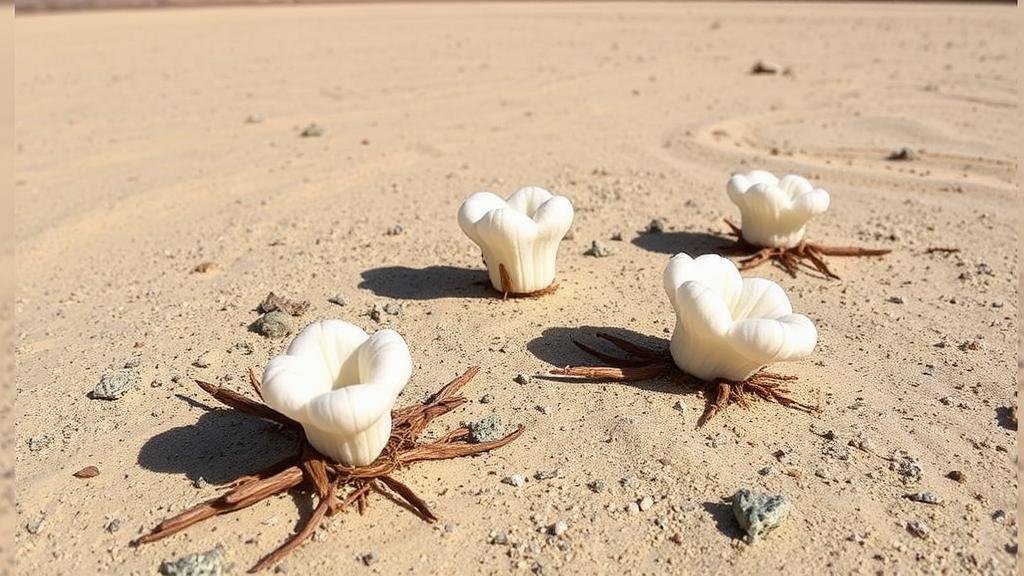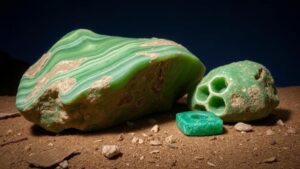Unearthing desert roses, gypsum formations shaped like flowers, in the sandy flats near Deming.
Unearthing Desert Roses: A Guide for Rockhounds and Mineral Collectors
Desert roses are captivating mineral formations primarily made of gypsum, creating stunning rosette shapes that resemble the petals of a flower. Located in the sandy flats near Deming, New Mexico, these formations offer a unique opportunity for rockhounds and mineral collectors. This article aims to provide an in-depth look at desert roses, their formation, and tips for collectors interested in unearthing these natural wonders.
Understanding Desert Roses
Desert roses are a type of selenite, which is a crystalline form of gypsum. Scientifically known as gypsum rose, these formations are formed under arid conditions when gypsum precipitates from evaporating seawater. As the water evaporates, the remaining minerals crystallize, often creating beautiful rosette shapes with petals radiating from a central point. These structures can vary in size, typically measuring anywhere from a few centimeters to several inches.
A fascinating characteristic of desert roses is their color. While they are often a hue of creamy white or light beige, they can also present shades of pink and brown, depending on the presence of iron oxide and other trace minerals. Also, the average hardness of gypsum on the Mohs scale is around 2, making these formations relatively soft and easy to work with for collectors.
Geological Significance
The geological processes that lead to the formation of desert roses highlight the environmental conditions in which they develop. These formations are predominantly found in arid climates where water bodies have existed in the past. For example, during the Late Cretaceous period, the region now surrounding Deming was once submerged under a shallow sea. With the drying of this sea, various sedimentary minerals, including gypsum, began to crystallize, resulting in the striking formations seen today.
When examining these formations, collectors will notice distinct patterns and textures that can tell the story of their formation. The presence of sand grains trapped within the crystals can enhance their beauty and provides insight into the environmental conditions at the time of their creation.
Collecting Desert Roses in Deming
The sandy flats near Deming, New Mexico, offer one of the best locations for rockhounds to discover desert roses. If you are planning a collecting trip, here are some practical tips:
- Research the best locations: Popular spots for desert rose hunting include the areas near the Florida Mountains and the vicinity of the Deming airport. Local mining claims can sometimes be accessed with permissions, providing excellent opportunities for collectors.
- Right tools matter: Equip yourself with basic collecting tools such as a small pick, a brush, and a sturdy bag for transport. Since desert roses are relatively soft, a gentle touch is recommended to avoid damaging them.
- Best time to visit: The ideal time to go collecting in the Deming area is during the spring and fall months when temperatures are milder, making it more comfortable to spend hours outdoors.
- Follow the weather: Check the weather forecast before your trip, as rain can cause the sandy flats to become muddy, hindering the search for desert roses.
Cleaning and Preparing Desert Roses
Once you have successfully collected your desert roses, cleaning and preparing them for display is essential. Here are some effective steps:
- Gently brush off loose sand and debris with a soft brush. Avoid strong soaps or chemicals that may damage the gypsum.
- For stubborn dirt, soaking the specimen in water for a brief period can help. Ensure that you dry the desert rose thoroughly afterward to prevent moisture damage.
- Consider displaying your desert rose in a glass case to prevent dust buildup while showcasing its beauty.
Environmental Considerations and Ethical Collecting
As with all forms of collecting, ethical practices are essential in preserving natural resources. When unearthing desert roses:
- Always obtain the necessary permits for collecting on public or private land.
- Take only what you need and avoid overharvesting areas, which can contribute to environmental degradation.
- Educate others about responsible collecting practices, fostering a community that values and respects natural treasures.
Conclusion
Unearthing desert roses in the sandy flats near Deming provides a unique and rewarding experience for rockhounds and mineral collectors alike. These exquisite gypsum formations not only serve as a testament to the geological history of the area but also as beautiful collectors items. By following the tips outlined above, you can maximize your collecting efforts while ensuring that these natural wonders remain accessible for future generations. Whether for educational purposes, display, or personal enjoyment, desert roses are a captivating addition to any mineral collection.



